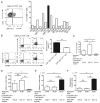Determination of a Key Antigen for Immunological Intervention To Target the Latent Stage of Toxoplasma gondii
- PMID: 28446567
- PMCID: PMC5473426
- DOI: 10.4049/jimmunol.1700062
Determination of a Key Antigen for Immunological Intervention To Target the Latent Stage of Toxoplasma gondii
Abstract
Toxoplasma gondii, an obligate intracellular protozoan parasite, establishes a chronic infection by forming cysts preferentially in the brain. Up to one third of the human population worldwide is estimated to be chronically infected with this parasite. However, there is currently no drug effective against the cyst form of the parasite. In addition, the protective immunity against the cysts remains largely unknown. We analyzed the molecular mechanisms by which the immune system detects host cells harboring the cysts to eliminate the latent stage of the parasite using mice with the H-2d haplotype, which are genetically resistant to the infection. Our study revealed that CD8+ immune T cells bearing TCR Vβ8.1, 8.2 chain have a potent activity to remove T. gondii cysts from the brain. Our studies also uncovered that H-2Ld is the major Ag-presenting molecule to CD8+ T cells for initiating cyst elimination, and that CD8+Vβ8.1, 8.2+ immune T cells recognize the N-terminal region (aa 41-152) of dense granule protein 6 (GRA6Nt) of the parasite presented by the H-2Ld molecule. Furthermore, CD8+ immune T cells induced by immunization with recombinant GRA6Nt were eventually capable of removing the cysts from the brain when transferred to infected immunodeficient mice lacking T cells. Thus, GRA6Nt is a novel and potent Ag to activate CD8+ T cells capable of removing T. gondii cysts. These observations offer a basis for immunological intervention to combat chronic infection with T. gondii by targeting the persistent cysts of the parasite.
Copyright © 2017 by The American Association of Immunologists, Inc.
Conflict of interest statement
The authors have no financial conflicts of interest.
Figures





Similar articles
-
A pathway to cure chronic infection with Toxoplasma gondii through immunological intervention.Parasitol Int. 2021 Apr;81:102259. doi: 10.1016/j.parint.2020.102259. Epub 2020 Dec 1. Parasitol Int. 2021. PMID: 33271362 Free PMC article. Review.
-
Strain- and Dose-Dependent Reduction of Toxoplasma gondii Burden in Pigs Is Associated with Interferon-Gamma Production by CD8+ Lymphocytes in a Heterologous Challenge Model.Front Cell Infect Microbiol. 2017 Jun 8;7:232. doi: 10.3389/fcimb.2017.00232. eCollection 2017. Front Cell Infect Microbiol. 2017. PMID: 28642841 Free PMC article.
-
DNA immunization with eukaryotic initiation factor-2α of Toxoplasma gondii induces protective immunity against acute and chronic toxoplasmosis in mice.Vaccine. 2013 Dec 16;31(52):6225-31. doi: 10.1016/j.vaccine.2013.10.034. Epub 2013 Oct 31. Vaccine. 2013. PMID: 24183979
-
Dynamic imaging of T cell-parasite interactions in the brains of mice chronically infected with Toxoplasma gondii.J Immunol. 2009 May 15;182(10):6379-93. doi: 10.4049/jimmunol.0804307. J Immunol. 2009. PMID: 19414791
-
Characteristics and critical function of CD8+ T cells in the Toxoplasma-infected brain.Semin Immunopathol. 2015 May;37(3):261-70. doi: 10.1007/s00281-015-0487-3. Epub 2015 Apr 22. Semin Immunopathol. 2015. PMID: 25898888 Free PMC article. Review.
Cited by
-
The immune system utilizes two distinct effector mechanisms of T cells depending on two different life cycle stages of a single pathogen, Toxoplasma gondii, to control its cerebral infection.Parasitol Int. 2020 Jun;76:102030. doi: 10.1016/j.parint.2019.102030. Epub 2019 Nov 25. Parasitol Int. 2020. PMID: 31778800 Free PMC article. Review.
-
Presence of Toxoplasma gondii infection in brain as a potential cause of risky behavior: a report of 102 autopsy cases.Eur J Clin Microbiol Infect Dis. 2019 Feb;38(2):305-317. doi: 10.1007/s10096-018-3427-z. Epub 2018 Nov 23. Eur J Clin Microbiol Infect Dis. 2019. PMID: 30470966 Free PMC article.
-
The amino-terminal region of dense granule protein 6 of Toxoplasma gondii stimulates IFN-γ production by microglia.Microbes Infect. 2020 Sep;22(8):375-378. doi: 10.1016/j.micinf.2019.12.003. Epub 2020 Jan 20. Microbes Infect. 2020. PMID: 31972245 Free PMC article.
-
A pathway to cure chronic infection with Toxoplasma gondii through immunological intervention.Parasitol Int. 2021 Apr;81:102259. doi: 10.1016/j.parint.2020.102259. Epub 2020 Dec 1. Parasitol Int. 2021. PMID: 33271362 Free PMC article. Review.
-
Rhoptry and Dense Granule Secreted Effectors Regulate CD8+ T Cell Recognition of Toxoplasma gondii Infected Host Cells.Front Immunol. 2019 Sep 6;10:2104. doi: 10.3389/fimmu.2019.02104. eCollection 2019. Front Immunol. 2019. PMID: 31555296 Free PMC article.
References
-
- Montoya JG, Liesenfeld O. Toxoplasmosis. Lancet. 2004;363:1965–1976. - PubMed
-
- Munoz M, Liesenfeld O, Heimesaat MM. Immunology of Toxoplasma gondii. Immunol Rev. 2011;240:269–285. - PubMed
-
- Suzuki Y, Orellana MA, Schreiber RD, Remington JS. Interferon-gamma: the major mediator of resistance against Toxoplasma gondii. Science. 1988;240:516–518. - PubMed
-
- Israelski DM, Remington JS. Toxoplasmosis in the non-AIDS immunocompromised host. In: Remington JS, Swrltz M, editors. Curr Clin Top Infect Dis. Blackwell Scientific Publications; London: 1993. pp. 322–356. - PubMed
Publication types
MeSH terms
Substances
Grants and funding
LinkOut - more resources
Full Text Sources
Other Literature Sources
Research Materials

